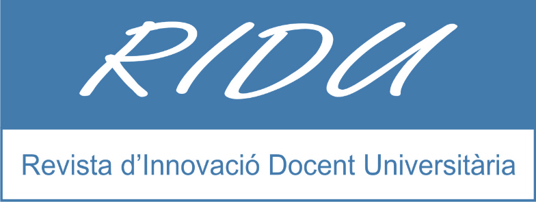A 30 anys del “País de los vivos”. Una experiència de l’ús didàctic del vídeo a l’aula
DOI:
https://doi.org/10.1344/RIDU2023.15.1Paraules clau:
Vídeo a l’aula, Cinema, Cultura, Hàbits i actituds, Desenvolupament econòmic, UruguaiResum
L’objectiu d’aquest article és presentar una experiència d’ús didàctic del vídeo a l’aula. En el curs de Desenvolupament Econòmic de l’Uruguai, de la Llicenciatura en Economia (FCEA-UdelaR), es va realitzar sis tallers que posen en pràctica diferents eines didàctiques i, una d’elles, consisteix a treballar amb la previsualització d’una pel·lícula. Un dels articles de referència del curs és “El país de los vivos” de Martín Rama, de 1991, que planteja certes característiques de la societat uruguaiana com ara hàbits i costums (risc moral), les quals s’il·lustren, a classe, a través d’un dels films capdavanters del cinema nacional: “El baño del Papa”. El taller ha canviat en la seva proposta en el transcurs dels anys, alternant redaccions d’informes, amb discussions a classe, treballs en grup i la realització de peces audiovisuals. Els principals aprenentatges de l’experiència han estat tres. En primer lloc, la utilització de films a la classe, proveeix de condicions més favorables per a moure des de situacions concretes a la construcció de conceptes en allò abstracte. En segon lloc, els mitjans audiovisuals es constitueixen, de fet, en un suport rellevant perquè els estudiants es converteixin en protagonistes del seu propi procés d’aprenentatge. En tercer lloc, i de manera que transcendeix la formació curricular, es tracta d’una activitat que permet aprofitar l’eina per a endinsar als estudiants en el coneixement del patrimoni cultural nacional.
Referències
Abramovitz, M. (1986). Catching Up, Forging Ahead, and Falling Behind. Journal of Economic History, 46(2), 385-406. https://doi.org/10.1017/S0022050700046209
Abramovitz, M. (1989). Thinking about growth. En M. Abramovitz (Ed.), Thinking about growth and other essays on economic growth and welfare (pp. 3-79). Cambridge University Press. https://doi.org/10.1017/CBO9780511664656
Barros, C., y Barros, R. (2015). Los medios audiovisuales y su influencia en la educación desde alternativas de análisis. Revista Universidad y Sociedad [seriada en línea], 7(3), 26-31.
Caparros, J. (2008). Grandes acontecimientos históricos contemporáneos en el cine. En G. Camarero, B. Heras, y V. Cruz, (Eds.), Una ventana indiscreta: la historia desde el cine (pp. 131-147). Ediciones JC.
Carracedo, C. (2009). Diez ideas para aplicar el cine en el aula [Ponencia presentada]. I Congreso de español como lengua extranjera en Asia-Pacífico (CE/LEAP), Instituto Cervantes y Embajada de España en Manila.
Cruz, G., y Galeana de la O., L. (2013). Los fundamentos biológicos del aprendizaje para el diseño y aplicación de objetos de aprendizaje. Centro Universitario de Producción de Medios Didácticos. Universidad de Colima.
Dias-Trindade, S., Moreira, J., y Rigo, R. (2021). O cinema como recurso pedagógico promotor de engagement na educação superior. Praxis & Saber, 12(29), 1934. https://doi.org/10.19053/22160159.v12.n29.2021.11934
Dussel, I. (2008). Los desafíos de las nuevas alfabetizaciones. Las transformaciones en la escuela y en la formación docente. Instituto Nacional de Formación Docente.
Gabinete de Comunicación y Educación de la Universidad Autónoma de Barcelona (GCE-UAB) (2015). Perspectivas 2015: El uso del audiovisual en las aulas. La situación en España. Editorial Planeta.
García Schlee, A., Murguía, J., Raviolo, H., y Benavides, W. (1991). El día en que el Papa fue a Melo. Ediciones de la Banda Oriental.
Macías-Guillén, A. (2018). Experiencia en la creación de vídeos didácticos por parte de los estudiantes como elemento motivador y herramienta de apoyo a la docencia. En C. Cáceres Taladriz, N. Esteban, M. C. Gálvez de la Cuesta, y B. Rivas Rebaque (Eds.), Innovación y transformación digital: estrategias y metodologías docentes en Educación Superior (pp. 227-238). Editorial DYKINSON, S.L.
Maddison, A. (1988). Ultimate and proximate growth causality: A critique of Mancur Olson on the rise and decline of nations. Scandinavian Economic History Review, 36(2), 25-29. https://doi.org/10.1080/03585522.1988.10408114
Mérida, M. (2013). El audiovisual: recurso educativo facilitador de aprendizaje significativo. Recuperado el 15/03/2022 de https://sid.uncu.edu.ar/sid/cda/noticias-sobre-documentacion-audiovisual/7029-2/
Moore, G. A. (1996). Crossing the Chasm. Harper Business.
Pac, D., y García, N. (2013). El cine como herramienta de aprendizaje en el aula. Claves de una experiencia docente multidisciplinar en el ámbito económico. Revista Internacional de Organizaciones, 10, 181-197. https://doi.org/10.17345/rio10.181-197
Programa de Alfabetización Audiovisual-Subsecretaría de Comunicación (PAA-SC-SF) (2017). Alfabetización Audiovisual: Uso de material audiovisual en el aula. Ministerio de Educación de Santa Fe, Argentina.
Rama, M. (1991). El país de los vivos: un enfoque económico. Revista SUMA, Centro de Investigaciones Económicas 6(11), 7-36.
Rodríguez-López, J. (2017). El videoclip interactivo. Nuevos modelos de alfabetización mediática en adolescentes. Revista Mediterránea de Comunicación/Mediterranean Journal of Communication, 8(2), 161-167. https://www.doi.org/10.14198/MEDCOM2017.8.2.11
Rodrik, D. (Ed.) (2003). In Search of Prosperity. Analytic Narratives on Economic Growth. Princeton University Press.
Sacaluga, I., y Pérez, A. (2017). Medios audiovisuales y Carnaval de Cádiz: una combinación útil como recurso didáctico. Aula de Encuentro, 19(2), 170-193. https://doi.org/10.17561/ae.v19i2.7
Sánchez-Nielsen, E. (2012). Creaciones de contenidos audiovisuales producidos por los estudiantes como nuevo instrumento en el proceso de la enseñanza y aprendizaje: metodología y resultados. Actas XVIII JENUI 2012, Ciudad Real, 223-230.
Szirmai, A. (2012). Proximate, intermediate and ultimate causality: Theories and experiences of growth and development. UNU-MERIT, Maastricht Economic and Social Research and Training Centre on Innovation and Technology. UNU-MERIT Working Papers No. 032.
Uruguay Film Commission & Promotion Office (2012). El baño del Papa. En L. Bortagaray (Ed.), 25 años de cine de ficción (1985-2010) (p. 27). Montevideo.
Descàrregues
Publicades
Número
Secció
Llicència
Drets d'autor (c) 2023 Henry Willebald, Sabrina Siniscalchi

Aquesta obra està sota una llicència internacional Creative Commons Reconeixement 4.0.
L'autor/a que publica en aquesta revista accepta les condicions següents:
- L'autor/a conserva els drets d’autoria i atorga a la revista el dret de primera publicació de l’obra.
- Els textos es difondran amb la llicència de reconeixement 4.0 Espanya de Creative Commons, la qual permet compartir, distribuir, reproduir i la comunicació pública, sempre que se’n reconegui l’autoria i la revista.







